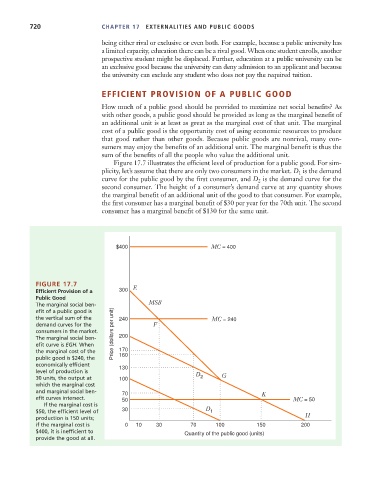Page 746 - Microeconomics, Fourth Edition
P. 746
c17ExternalitiesandPublicGoods.qxd 8/22/10 4:56 AM Page 720
720 CHAPTER 17 EXTERNALITIES AND PUBLIC GOODS
being either rival or exclusive or even both. For example, because a public university has
a limited capacity, education there can be a rival good. When one student enrolls, another
prospective student might be displaced. Further, education at a public university can be
an exclusive good because the university can deny admission to an applicant and because
the university can exclude any student who does not pay the required tuition.
EFFICIENT PROVISION OF A PUBLIC GOOD
How much of a public good should be provided to maximize net social benefits? As
with other goods, a public good should be provided as long as the marginal benefit of
an additional unit is at least as great as the marginal cost of that unit. The marginal
cost of a public good is the opportunity cost of using economic resources to produce
that good rather than other goods. Because public goods are nonrival, many con-
sumers may enjoy the benefits of an additional unit. The marginal benefit is thus the
sum of the benefits of all the people who value the additional unit.
Figure 17.7 illustrates the efficient level of production for a public good. For sim-
plicity, let’s assume that there are only two consumers in the market. D is the demand
1
curve for the public good by the first consumer, and D is the demand curve for the
2
second consumer. The height of a consumer’s demand curve at any quantity shows
the marginal benefit of an additional unit of the good to that consumer. For example,
the first consumer has a marginal benefit of $30 per year for the 70th unit. The second
consumer has a marginal benefit of $130 for the same unit.
$400 MC = 400
FIGURE 17.7
Efficient Provision of a 300 E
Public Good
The marginal social ben- MSB
efit of a public good is
the vertical sum of the 240 MC = 240
demand curves for the F
consumers in the market. Price (dollars per unit)
The marginal social ben- 200
efit curve is EGH. When
the marginal cost of the 170
160
public good is $240, the
economically efficient 130
level of production is
30 units, the output at 100 D 2 G
which the marginal cost
and marginal social ben- 70
efit curves intersect. 50 K MC = 50
If the marginal cost is
$50, the efficient level of 30 D 1
production is 150 units; H
if the marginal cost is 0 10 30 70 100 150 200
$400, it is inefficient to Quantity of the public good (units)
provide the good at all.

